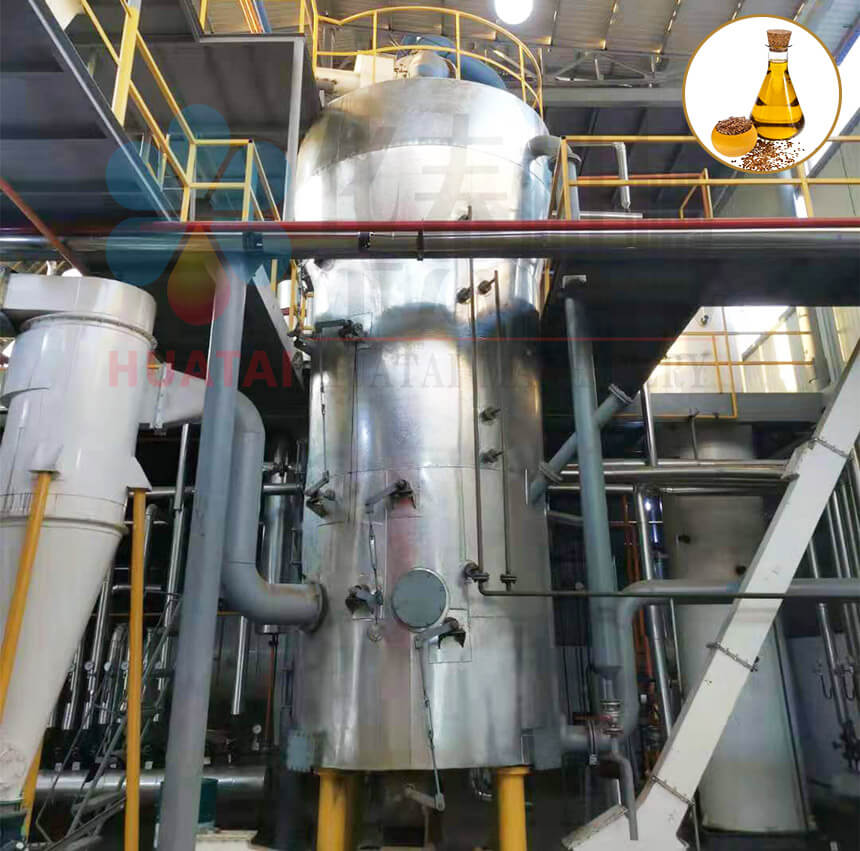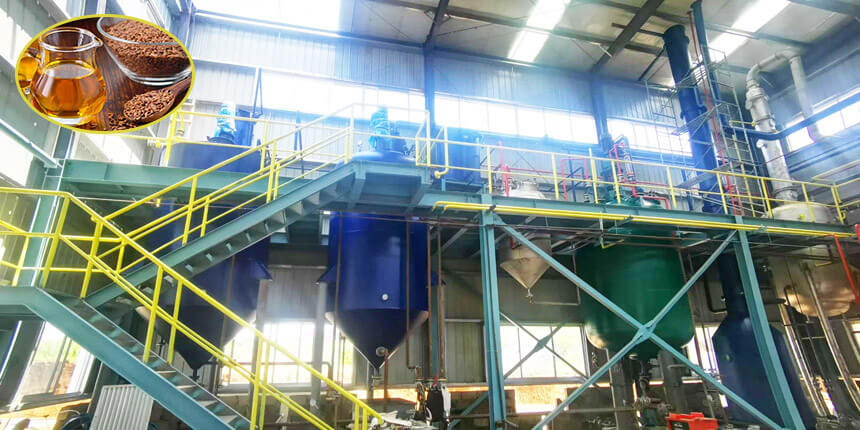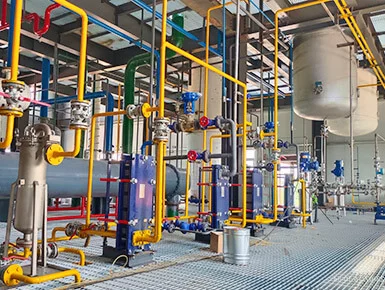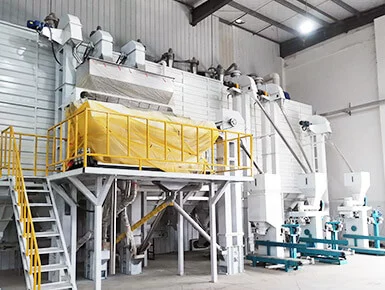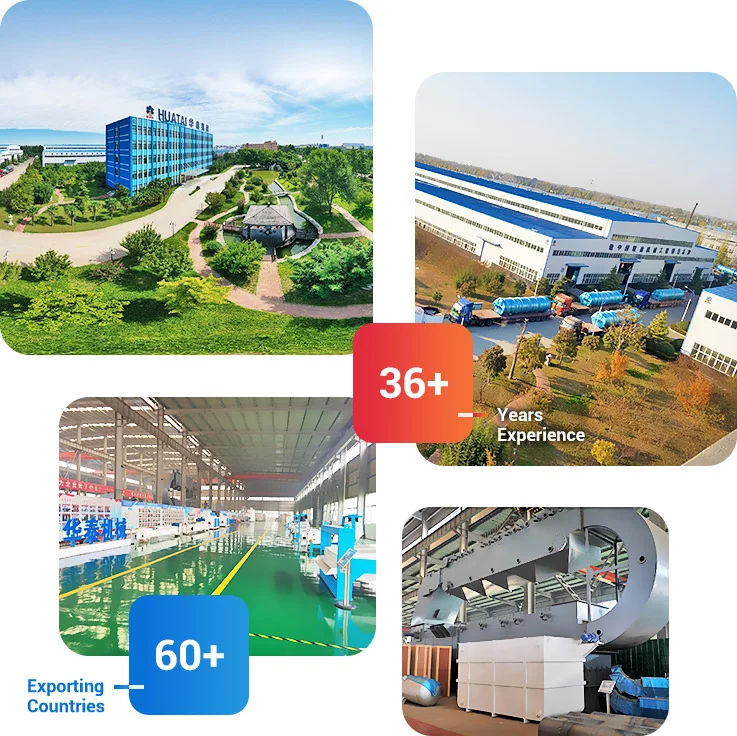
Introduction
In this guide, you will learn about the complete linseed oil refining process and refining plant investment cost. And the difference between refined linseed oil, cold-pressed and crude.
Whether you're planning a new linseed oil processing plant or upgrading existing flaxseed oil processing line, Henan Huatai Group helps you through every step of professional linseed oil process.
What Is Refined Linseed Oil?
Refined linseed oil is an edible oil obtained by purifying crude linseed oil by physical and chemical processing. The crude oil comes from pressing or solvent extraction of flaxseeds. The refined flaxseed oil is light yellow and transparent, contains no sediment, and offers a mild taste with no off-flavors.
Research shows, refined linseed oil contains about 50-55% α-linolenic acid, free fatty acids ≤0.1%, and phospholipid content ≤0.01%. It has a high smoke point, low acid value, and extended shelf life, making it suitable for various cooking methods and food processing applications.
Four Steps of Linseed Oil Refining Process
Linseed oil refining process includes a multi-stage continuous process. Depending on investment scale and processing requirements, manufacturers can choose batch, semi-continuous, or fully continuous production methods. Here are the four steps:
![Linseed oil degumming system Linseed oil degumming system]()
Step 1: Linseed Oil Degumming
Degumming removes colloidal impurities from crude linseed oil, including phospholipids, proteins, and mucilaginous substances. These impurities cause oil to foam, smoke, and darken when heated. The main degumming methods include water degumming, acid degumming, and enzymatic degumming.
- Water degumming: This most commonly used method. It uses hot water or steam to make hydrophilic phospholipids in crude oil absorb water and swell. Then, removes these coagulated substances by centrifugal separation. In this process, temperatures between 70-80°C, add water at 2-3% of crude oil weight, and stir for about 30 minutes. Water degumming removes most hydratable phospholipids but has limited efficacy against non-hydrated phospholipids.
- Acid degumming: This method specifically targets non-hydratable phospholipids. Use food-grade phosphoric acid or citric acid to convert non-hydratable phospholipids into hydratable forms, then remove them by hydration. This method achieves more thorough degumming, reduces metal ion content in the oil, and improves oxidative stability.
- Enzymatic degumming: This new degumming technology uses specific phospholipases to break down phospholipids, causing them to lose surface activity and separate. The method has mild conditions, high yield, and no pollution, but it costs more than conventional methods.
After degumming, the phospholipid content in flaxseed oil drops from an initial 0.5-1.0% to below 0.01%. The process also reduces some metal ions, creating favorable conditions for subsequent alkali refining and deacidification.
![Linseed oil alkali refining equipment Linseed oil alkali refining equipment]()
Step 2: Linseed Oil Neutralization
Neutralization, also called alkali refining and deacidification, mainly removes free fatty acids (FFA) from crude oil while removing some pigments, phospholipids, and oxidation products.
The basic principle is mixing appropriate amounts of alkali solution (sodium hydroxide) with degummed linseed oil. The alkali reacts with free fatty acids through saponification, generating soapstock, separate by centrifugation.
Henan Huatai Group's neutralization process uses two modes: low-temperature long mixing and high-temperature short mixing.
- Low-temperature long mixing: Control oil temperature at 30-40°C, use alkali solution at 10-14 Bé concentration, and mix for about 30 minutes. This suits crude oil with medium free fatty acid content (3-5%).
- High-temperature short mixing: Uses oil temperature of 75-90°C with higher alkali solution concentration (14-16 Bé), requiring only a few minutes of mixing time. It is suitable for processing high-acid crude oil.
After neutralization, the free fatty acid content in flaxseed oil drops from 2-5% to below 0.1%. The oil color improvement and smoke point increase substantially. Manufacturers can use the separated soapstock to produce fatty acids or vegetable pitch, achieving value-added utilization of by-products.
![Linseed oil bleaching system Linseed oil bleaching system]()
Step 3: Linseed Oil Bleaching
Bleaching, also called decolorization, uses adsorbents to remove pigments, residual soapstock, and oxidation products from oil. Linseed oil naturally contains pigments like chlorophyll and carotenoids, which affect appearance and stability and require bleaching.
The bleaching process mainly uses adsorptive decolorization methods, using bleaching earth, activated carbon, and other adsorbents to treat oil under vacuum conditions. Add activated bleaching earth at 1-3% of oil weight, keep temperature at 100-110°C, and for 20-30 minutes.
After decolorization, the linseed oil color reduces from Yellow 35-Red 10 (Lovibond colorimeter 133.4mm cell) to below Yellow 20-Red 2.0. The process further removes residual phospholipids, soapstock, and metal ions, improving the oil's oxidative stability and safety.
Henan Huatai Intelligent Equipment Group's edible oil decolorization equipment system includes bleaching tanks, vacuum systems, and filter units, forming a closed continuous production line. Feel free to contact us anytime for more information.
![Linseed oil deodorization tower Linseed oil deodorization tower]()
Step 4: Linseed Oil Deodorization
Deodorization is the final step in linseed oil refinery. It removes odor substances, free fatty acids, and oxidation decomposition products from the oil, improving smoke point and stability. The characteristic "raw fishy smell" of flaxseed oil mainly comes from aldehydes, ketones, and volatile hydrocarbon substances, which deodorization removes.
Deodorization is based on steam distillation. Under high temperature (180-240°C) and high vacuum (absolute pressure 2-5 mbar), use direct steam to carry out and discharge volatile odor substances from linseed oil. Deodorization time ranges from 30-120 minutes, depending on the oil's initial condition and final requirements.
Henan Huatai Group deodorization process features:
- Use staged heating to avoid local overheating
- Use soft tower deodorization system to reduce oil residence time at high temperatures
- Adds antioxidants to protect the oil immediately after deodorization
After deodorization, linseed oil's smoke point increases to 215-220°C, higher than unrefined oil's 160-170°C, making it suitable for frying and high-temperature cooking. The oil's flavor becomes light and mild, and shelf life extends.
Note: must immediately cool deodorized flaxseed oil and protect it with nitrogen to prevent oxidation reversion and ensure oil quality.
Refined Linseed Oil vs Cold Pressed vs Crude
| Indicators |
Refined linseed oil |
Cold-pressed linseed oil |
Crude linseed oil |
| Processing Steps |
Multi-stage refining: degumming, deacidification, decoloration, deodorization |
Linseeds are directly low-temperature pressing after cleaning, and then only by physical filtration |
After pressing or extraction, only simple filtration |
| Processing Temperature |
High temperature during deodorization (180-240°C), medium-low temperature during other stages |
<60°C |
Hot pressing method: around 90°C, cold pressing method: <60°C |
| Appearance |
Pale yellow, clear and transparent |
Golden yellow, maybe slightly cloudy |
Deep yellow to brownish, cloudy with sediment |
| Flavor |
Mild with no off-flavors |
Rich raw flaxseed taste, full-bodied |
Strong flaxseed flavor, may have a burnt taste |
| Smoke Point |
215-220°C |
160-170°C |
150-160°C |
| α Linolenic Acid Content |
50-55% |
57-60% |
55-58% |
| Free Fatty Acids |
≤0.1% |
0.5-2.0% |
2-5% or higher |
| Phospholipid Content |
≤0.01% |
0.5-1.0% |
1-2% |
| Vitamin E Retention |
60-70% |
>95% |
Close to 100% |
| Peroxide Value |
≤2.0 meq/kg |
Variable, usually ≤5.0 meq/kg |
Variable, may be as high as 10 meq/kg |
| Stability |
High, shelf life 18-24 months |
Low, shelf life 6-12 months, requires refrigeration |
Very low, prone to rancidity, should be used as soon as possible |
| Main Uses |
High-temperature cooking, food processing, raw material for health products, industrial applications |
low-temperature cold dishes, direct consumption of health products |
Industrial uses, biodiesel feedstock |
What Uses Refined Linseed Oil?
Refined linseed oil has wide applications due to its high smoke point, mild flavor, excellent stability, and rich α-linolenic acid content.
Food Industry
- Cooking and frying oil: The high smoke point makes it suitable for home cooking and industrial frying, producing products like French fries and instant noodles.
- Food ingredients: As a premium baking oil and as a base for salad dressings and condiments.
- Functional foods and health supplements: As raw material for ω-3 supplements, nutritionally fortified foods, and special medical foods. It appears widely in soft capsules, blended oils, and other health products.
Other Industries
- Paints and inks: As film-forming substance and binder for eco-friendly paints and inks, providing excellent adhesion and toughness.
- Wood protection and surface treatment: Use it in wood varnishes and wood protection oils, improve water resistance and UV protection.
- Cosmetics and personal care products: As a base for skin creams, lip balms, and other products, it has skin affinity and moisturizing repair functions.
Is Refined Linseed Oil Food Safe?
Yes, refined linseed oil is completely safe for food use.
Major global food safety agencies (such as the US FDA and EU EFSA) recognize refined linseed oil as safe edible oil. Production strictly follows food safety standards in various countries (such as China's GB 2716), with for harmful substances like heavy metals and toxins.
![Large-scale flaxseed oil refinery plant Large-scale flaxseed oil refinery plant]()
Linseed Oil Refinery Plant Investment Cost Analysis
The investment cost for a linseed oil refinery plant varies significantly based on factors such as production scale, automation level, and equipment manufacturers. Below is an investment cost analysis for flaxseed oil refineries of different scales:
| Investment Components |
Batch(1-10 tons/day) |
Semi-continuous(10-30 tons/day) |
Fully continuous(30-100 tons/day) |
| Equipment |
$50,000-200,000 |
$200,000-800,000 |
$800,000-2 million |
| Land and Plant |
$80,000-140,000 |
$140,000-300,000 |
$300,000-850,000 |
| Installation and Commissioning |
$15,000-50,000 |
$50,000-160,000 |
$160,000-450,000 |
| Total Initial Investment |
$145,000-390,000 |
$390,000-1.26 million |
$1.26-3.3 million |
| Investment Payback Period |
3-5 years |
4-6 years |
5-7 years |
| Main Advantages |
Flexible investment, small footprint, low technical threshold |
Balances economy and flexibility, adaptable to various oilseeds |
High economies of scale, stable product quality, low labor costs |
Conclusion
Whether you're processing 10 tons per day or 500 tons per day, Huatai Intelligent Equipment Group customizes linseed oil refining systems to match your specific production goals and budget requirements.
Contact our engineering team today for a free consultation and detailed cost analysis. Let us help you transform crude linseed oil into premium refined oils that meet international quality standards and maximize your return on investment.
References:
![]() Service Coverage
Service Coverage
![]() FAQ
FAQ





